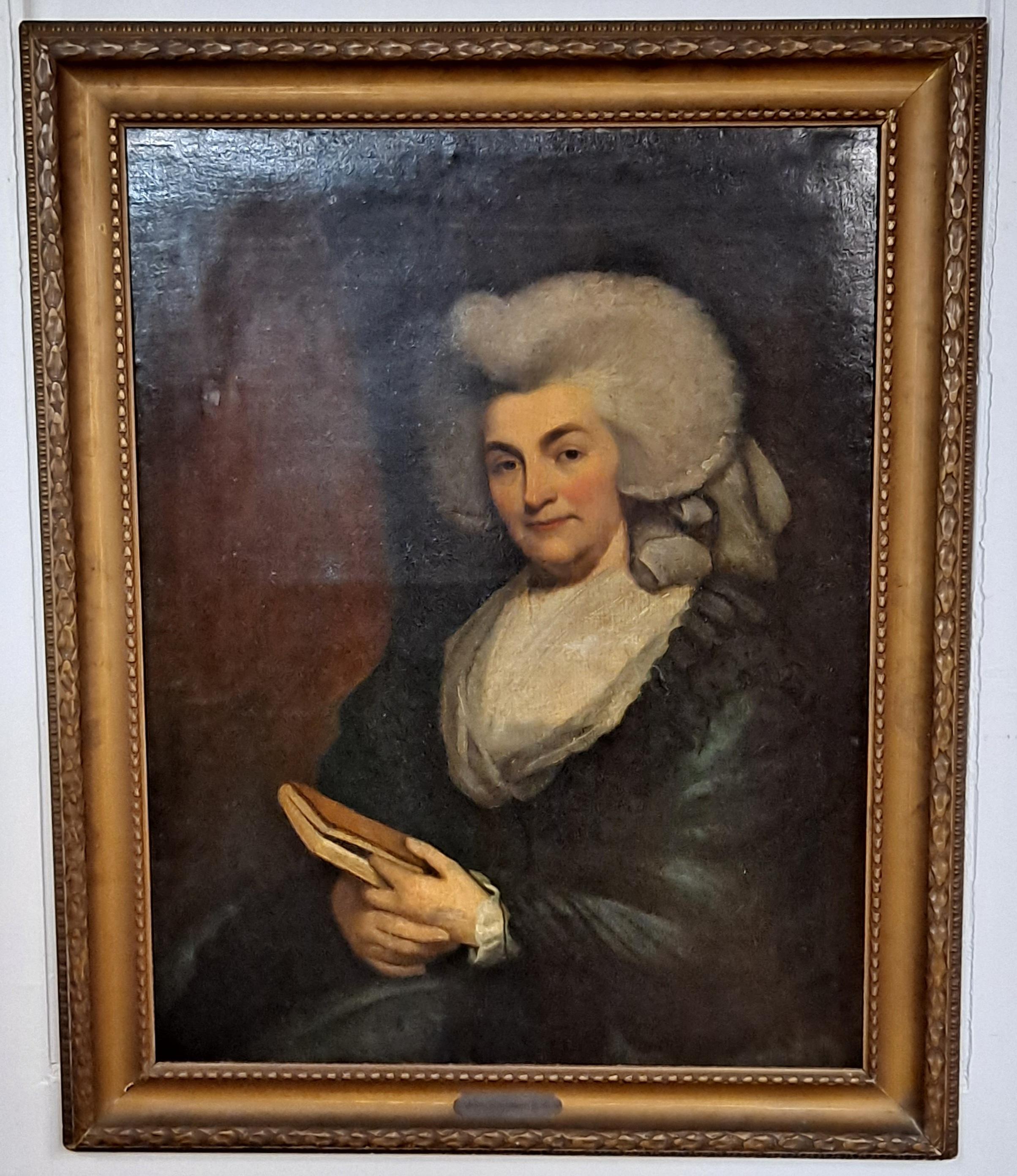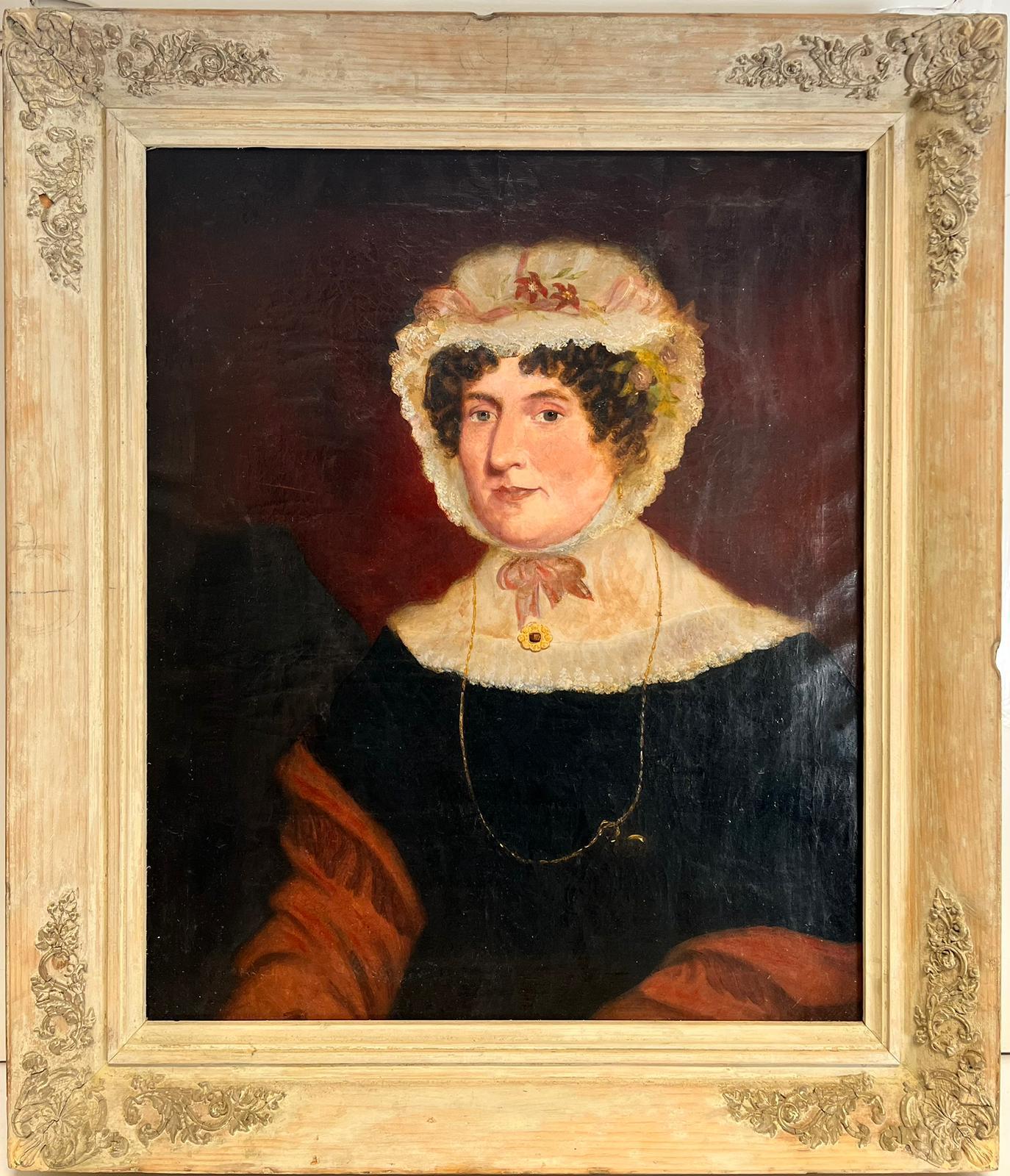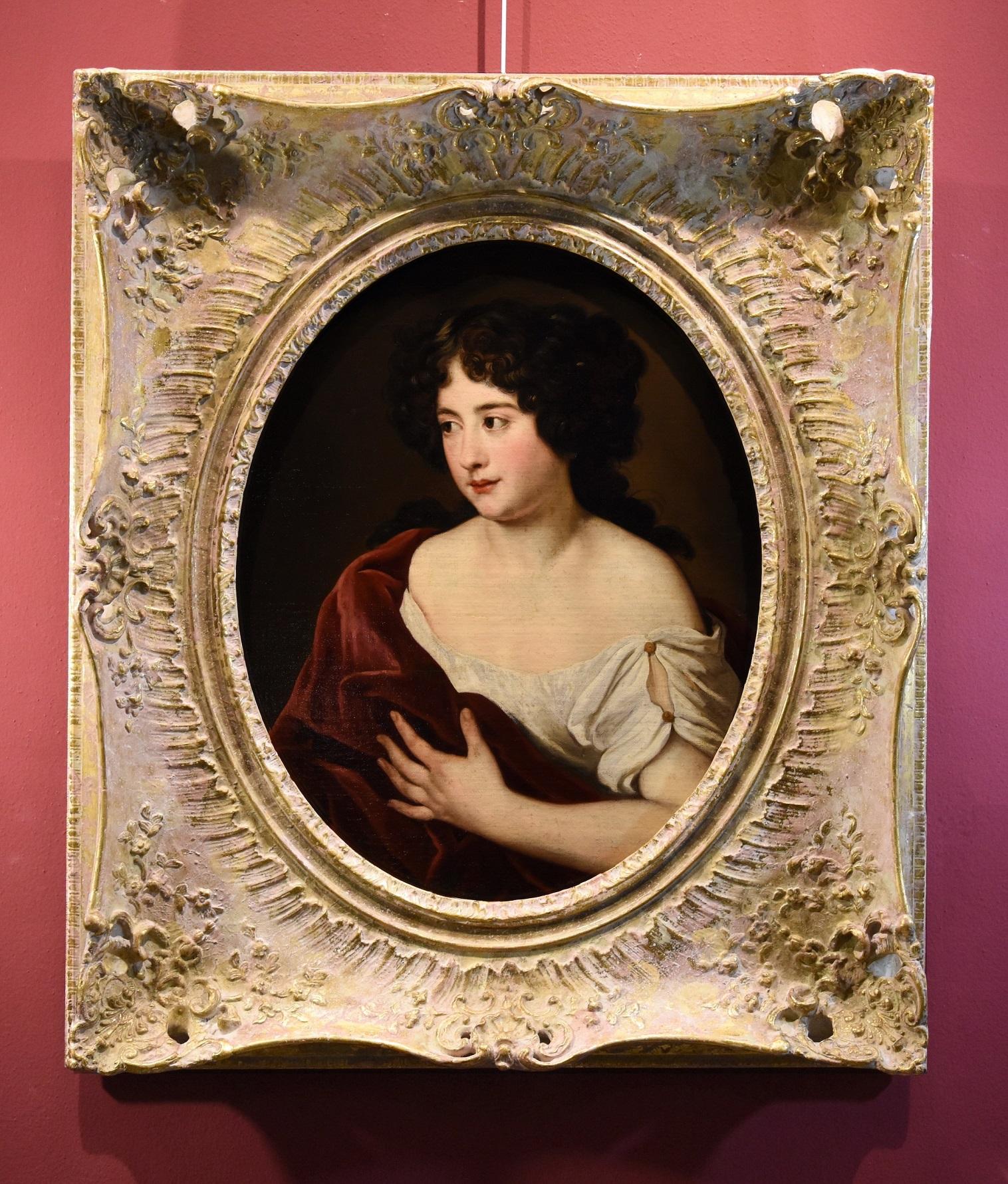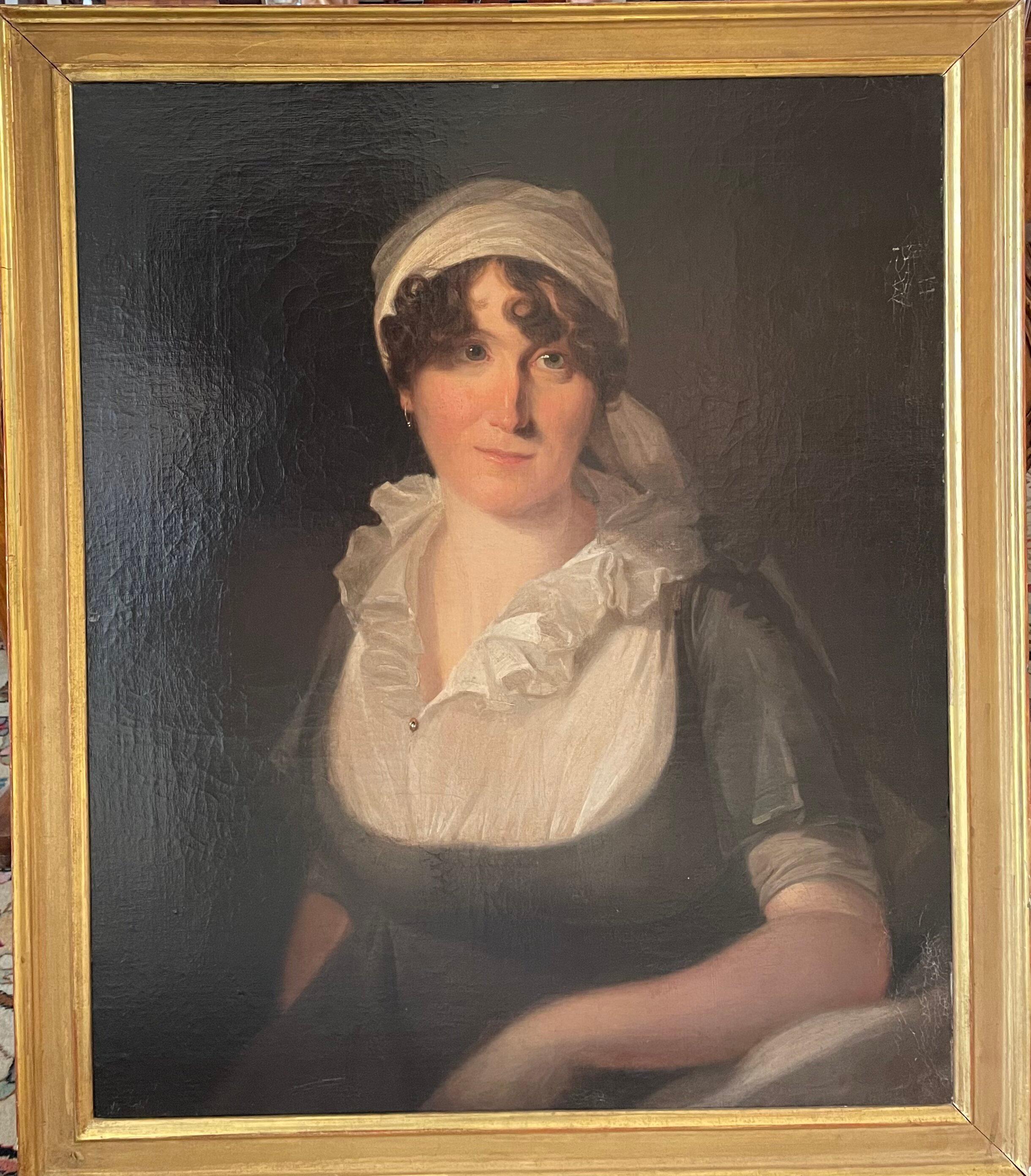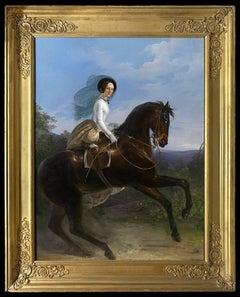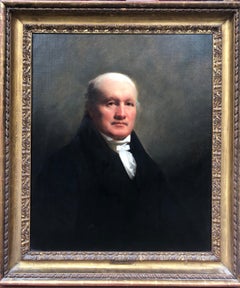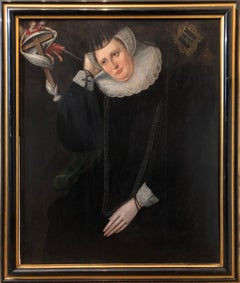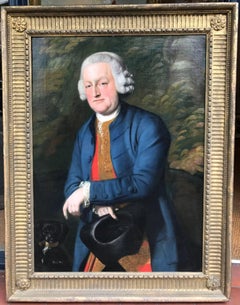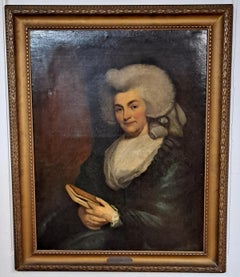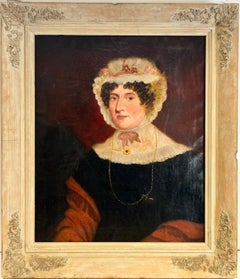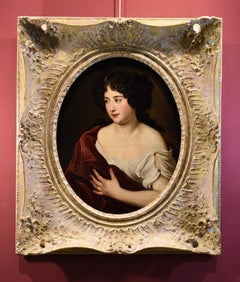Items Similar to 19th Century Oil Painting Portrait of a Muse
Want more images or videos?
Request additional images or videos from the seller
1 of 11
John Opie19th Century Oil Painting Portrait of a Musecirca 1802
circa 1802
$23,292.83
£17,000
€19,829.58
CA$31,905.36
A$35,485.72
CHF 18,529.54
MX$431,823.50
NOK 236,650.52
SEK 221,936.44
DKK 147,995.79
Shipping
Retrieving quote...The 1stDibs Promise:
Authenticity Guarantee,
Money-Back Guarantee,
24-Hour Cancellation
About the Item
John Opie RA (1761-1807, English)
c. 1802
Oil on canvas
Canvas dimensions 36 x 32 inches
Framed dimensions 46.5 x 43.25 inches
Original gilded period frame.
John Opie was a Cornish historical and portrait painter. He painted many great men and women of his day, including members of the British Royal Family, and others who were most notable in the artistic and literary professions.
This beautiful, ethereal sitter would have been painted in the later years of Opie's career after he developed his technique and his study of English literature. Opie's interests in Shakespearean plays, historical and mythological subjects can clearly be seen in this charming depiction of a muse who looks out at the viewer with a dream-like gaze. The contrasting dark background and the sitter's rich auburn hair against her porcelain skin, rougued cheeks and red lips on a elfin-like heart shape face, captivate the viewer's intimate attention.
Opie was born in Harmony Cottage, Trevellas, between St Agnes and Perranporth in Cornwall, UK. He was the youngest of the five children of Edward Opie, a master carpenter, and his wife Mary (née Tonkin). He showed a precocious talent for drawing and mathematics, and by the age of twelve he had mastered Euclid and opened an evening school for poor children where he taught reading, writing and arithmetic. His father, however, did not encourage his abilities, and apprenticed him to his own trade of carpentry.
Opie's artistic abilities eventually came to the attention of local physician and satirist, Dr John Wolcot (Peter Pindar), who visited him at the sawmill where he was working in 1775. Recognising a great talent, Wolcot became Opie's mentor, buying him out of his apprenticeship and insisting that he come to live at his home in Truro. Wolcot provided invaluable encouragement, advice, tuition and practical help in the advancement of his early career, including obtaining many commissions for work.
In 1781, having gained considerable experience as a portraitist travelling around Cornwall, Opie moved to London with Wolcot. There they lived together, having entered into a formal profit-sharing agreement. Although Opie had received a considerable artistic education from Wolcot, the doctor chose to present him as a self-taught prodigy; a portrait of a boy shown at the Society of Artists the previous year, had been described in the catalogue as "an instance of Genius, not having ever seen a picture." Wolcot introduced the "Cornish wonder" to leading artists, including Sir Joshua Reynolds, who was to compare him to Caravaggio and Velazquez, and to prospective patrons. The business arrangement with Wolcot lasted for a year, after which Opie informed the doctor that he now wished to go it alone, leading to the estrangement of the two former partners.
Through the influence of a Mrs Boscawen, Wolcot managed to have Opie introduced at the court of King George III. The King purchased one of his pictures and commissioned him to produce a portrait of Mary Delany. He also received commissions to paint the Duke and Duchess of Gloucester, Lady Salisbury, Lady Charlotte Talbot, Lady Harcourt and other ladies of the court. Opie's residence at "Orange Court", Castle Street, Leicester Fields, was said to be "crowded with rank and fashion every day" and he was the talk of the town. In 1782 he first exhibited at the Royal Academy and in December of that year was married to Mary Bunn. The match, however, proved to be an unhappy one and they were eventually divorced in 1796 after her elopement.
Opie's work, after an initial burst of popularity, rapidly fell out of fashion. In response to this he began to work on improving his technique, while at the same time seeking to supplement his early education by the study of Latin, French and English literature, and to polish his provincial manners by mixing in cultivated and learned circles. In 1786 he exhibited his first important historical subject, the Assassination of James I, and in the following year the Murder of Rizzio, a work whose merit was recognised by his immediate election as associate of the Royal Academy, of which he became a full member in 1788. He painted five subjects for John Boydell's Shakespeare Gallery; and until his death, his practice alternated between portraiture and historical work. In May 1798 he married Amelia Alderson whom he had met at a party in Norwich, having gone to Norfolk to carry out some commissions for Thomas Coke at Holkham Hall. They lived at 8 Berners Street, where Opie had moved in 1791.
Opie painted many notable men and women including Mary Wollstonecraft, Samuel Johnson, Francesco Bartolozzi, John Bannister, Joseph Munden, Charles James Fox, William Betty, Edmund Burke, John Crome, James Northcote, Henry Fuseli, Thomas Girtin, Robert Southey, Samuel Parr, Elizabeth Inchbald and Mary Shelley; 508 portraits in all, mostly in oil, and 252 other pictures.
- Creator:John Opie (1761 - 1807)
- Creation Year:circa 1802
- Dimensions:Height: 46.5 in (118.11 cm)Width: 43.25 in (109.86 cm)
- Medium:
- Period:
- Condition:
- Gallery Location:London, GB
- Reference Number:1stDibs: LU67335788342
About the Seller
5.0
Vetted Professional Seller
Every seller passes strict standards for authenticity and reliability
Established in 1990
1stDibs seller since 2017
42 sales on 1stDibs
- ShippingRetrieving quote...Shipping from: London, United Kingdom
- Return Policy
Authenticity Guarantee
In the unlikely event there’s an issue with an item’s authenticity, contact us within 1 year for a full refund. DetailsMoney-Back Guarantee
If your item is not as described, is damaged in transit, or does not arrive, contact us within 7 days for a full refund. Details24-Hour Cancellation
You have a 24-hour grace period in which to reconsider your purchase, with no questions asked.Vetted Professional Sellers
Our world-class sellers must adhere to strict standards for service and quality, maintaining the integrity of our listings.Price-Match Guarantee
If you find that a seller listed the same item for a lower price elsewhere, we’ll match it.Trusted Global Delivery
Our best-in-class carrier network provides specialized shipping options worldwide, including custom delivery.More From This Seller
View AllC19th Portrait Princesse de Joinville of Brazil - Spectacular fit for a palace
By Henri d'Ainecy Montpezat
Located in London, GB
Portrait of Princess de Joinville riding a Bay Horse
Henri d’Aincy, Le Comte Monpezat (French 1817-1859)
Painted circa 1837-9
oil on canvas
113 x 92 inches (including frame)
92 x 70 inches (unframed)
Provenance – from a private royal collection
This magnificent portrait depicts Princess de Joinville, the daughter of Pedro I, Emperor of Brazil and the King of Portugal. Through her illustrious family she was directly related Alexander III and Nicholas II of Russia and the Russian royal family, as well as to many of the great ruling families of Europe.
The work clearly confirms Monpezat as one of the most accomplished equestrian portrait painters in France in the early nineteenth century. In terms of scale, quality and dramatic power, it must surely be considered amongst his finest works. The stance of the powerful thoroughbred - in half rear - emphasises the calm nature and courage of the Princess.
Francisca of Brazil (1824-98) married a son of Louis Philippe I, the King of the French, and had three children. Born at the Imperial Palace of Saint Christopher, her youngest brother was the future Pedro II...
Category
1830s Old Masters Portrait Paintings
Materials
Oil
Striking 18th Century Portrait of the 12th Earl of Caithness
By Sir Henry Raeburn
Located in London, GB
Sir Henry Raeburn (1756-1823)
James Sinclair, 12th Earl of Caithness (1766-1823)
Oil on Canvas
30 X 25 inches Unframed
37 X 32 inches framed
Sir Henry Raeburn FRSE RA RSA (4 March 1756 – 8 July 1823) was a Scottish portrait painter and Scotland's first significant portrait painter since the Union to remain based in Scotland. He served as Portrait Painter to King George IV in Scotland.
Raeburn was born the son of a manufacturer in Stockbridge, on the Water of Leith: a former village now within the city of Edinburgh. He had an older brother, born in 1744, called William Raeburn. His ancestors were believed to have been soldiers, and may have taken the name "Raeburn" from a hill farm in Annandale, held by Sir Walter Scott's family. Orphaned, he was supported by William and placed in Heriot's Hospital, where he received an education. At the age of fifteen he was apprenticed to the goldsmith James Gilliland of Edinburgh, and various pieces of jewellery, mourning rings and the like, adorned with minute drawings on ivory by his hand, still exist. Soon he took to the production of carefully finished portrait miniatures; meeting with success and patronage, he extended his practice to oil painting, at which he was self-taught. Gilliland watched the progress of his pupil with interest, and introduced him to David Martin, who had been the favourite assistant of Allan Ramsay the Latter, and was now the leading portrait painter in Edinburgh. Raeburn was especially aided by the loan of portraits to copy. Soon he had gained sufficient skill to make him decide to devote himself exclusively to painting. George Chalmers (1776; Dunfermline Town Hall) is his earliest known portrait.
In his early twenties, Raeburn was asked to paint the portrait of a young lady he had noticed when he was sketching from nature in the fields. Ann was the daughter of Peter Edgar of Bridgelands, and widow of Count James Leslie of Deanhaugh. Fascinated by the handsome and intellectual young artist, she became his wife within a month, bringing him an ample fortune. The acquisition of wealth did not affect his enthusiasm or his industry, but spurred him on to acquire a thorough knowledge of his craft. It was usual for artists to visit Italy, and Raeburn set off with his wife. In London he was kindly received by Sir Joshua Reynolds, the president of the Royal Academy, who advised him on what to study in Rome, especially recommending the works of Michelangelo, and gave Raeburn letters of introduction for Italy. In Rome he met his fellow Scot Gavin Hamilton, Pompeo Girolamo Batoni and Byers, an antique dealer whose advice proved particularly useful, especially the recommendation that "he should never copy an object from memory, but, from the principal figure to the minutest accessory, have it placed before him." After two years of study in Italy he returned to Edinburgh in 1787, and began a successful career as a portrait painter. In that year he executed a seated portrait of the second Lord President Dundas.
Examples of his earlier portraiture include a bust of Mrs Johnstone of Baldovie and a three-quarter-length of Dr James Hutton: works which, if somewhat timid and tentative in handling and not as confident as his later work, nevertheless have delicacy and character. The portraits of John Clerk, Lord Eldin, and of Principal Hill of St Andrews belong to a later period. Raeburn was fortunate in the time in which he practised portraiture. Sir Walter Scott, Hugh Blair, Henry Mackenzie, Lord Woodhouselee, William Robertson, John Home, Robert Fergusson, and Dugald Stewart were resident in Edinburgh, and were all painted by Raeburn. Mature works include his own portrait and that of the Rev. Sir Henry Moncrieff Wellwood, a bust of Dr Wardrop of Torbane Hill, two full-lengths of Adam Rolland of Gask, the remarkable paintings of Lord Newton and Dr Alexander Adam in the National Gallery of Scotland, and that of William Macdonald of St Martin's. Apart from himself, Raeburn painted only two artists, one of whom was Sir Francis Leggatt Chantrey, the most important and famous British sculptor of the first half of the 19th century. It has recently been revealed that Raeburn and Chantrey were close friends and that Raeburn took exceptional care over the execution of his portrait of the sculptor, one of the painter's mature bust-length masterpieces.
It was commonly believed that Raeburn was less successful in painting female portraits, but the exquisite full-length of his wife, the smaller likeness of Mrs R. Scott Moncrieff in the National Gallery of Scotland, and that of Mrs Robert Bell, and others, argue against this. Raeburn spent his life in Edinburgh, rarely visiting London, and then only for brief periods, thus preserving his individuality. Although he, personally, may have lost advantages resulting from closer association with the leaders of English art, and from contact with a wider public, Scottish art gained much from his disinclination to leave his native land. He became the acknowledged chief of the school which was growing up in Scotland during the early 19th century, and his example and influence at a critical period were of major importance. So varied were his other interests that sitters used to say of him, "You would never take him for a painter till he seizes the brush and palette."
In 1812 he was elected president of the Society of Artists in Edinburgh; and in 1814 associate, and in the following year full member, of the Royal Scottish Academy. On 29 August 1822 he was knighted by George IV and appointed His Majesty's limner for Scotland at the Earl of Hopetoun house. He died in Edinburgh.
Raeburn had all the essential qualities of a popular and successful portrait painter. He was able to produce a telling and forcible likeness; his work is distinguished by powerful characterisation, stark realism, dramatic and unusual lighting effects, and swift and broad handling of the most resolute sort. David Wilkie recorded that, while travelling in Spain and studying the works of Diego Velázquez, the brushwork reminded him constantly of the "square touch" of Raeburn. Scottish physician and writer John Brown wrote that Raeburn "never fails in giving a likeness at once vivid, unmistakable and pleasing. He paints the truth, and he paints it with love".
Raeburn has been described as a "famously intuitive"portrait painter. He was unusual amongst many of his contemporaries, such as Reynolds, in the extent of his philosophy of painting directly from life; he made no preliminary sketches. This attitude partly explains the often coarse modelling and clashing colour combinations he employed, in contrast to the more refined style of Thomas Gainsborough and Reynolds. However these qualities and those mentioned above anticipate many of the later developments in painting of the 19th century from romanticism to Impressionism.
Sir Henry Raeburn died in St Bernard's House (17 St Bernards Crescent), Stockbridge, Edinburgh. He is buried in St. Cuthbert's churchyard against the east wall (the monument erected by Raeburn in advance) but also has a secondary memorial in the Church of St John the Evangelist, Edinburgh.
James Sinclair, 12th Earl of Caithness was born at Barrogill Castle (Castle of Mey) on 31 May 1766. He was the son of Sir John Sinclair of Mey, Baronet who he succeeded in the baronetcy in 1774. He succeeded as 12th earl of Caithness in 1789.
He was lord-lieutenant of the county of Caithness and lieutenant-colonel of the Ross-shire militia.
He married at Thurso Castle on 2 January 1784 Jane, second daughter of Alexander Campbell...
Category
18th Century Portrait Paintings
Materials
Oil
$29,595 Sale Price
40% Off
Free Shipping
Lady Dormore - A 16th Century Portrait of a key member of Shakespeare's England
Located in London, GB
Lady Dormer, Mary Browne
c. 1592
oil on panel
35 x 29 inches, unframed;
41 x 34.75 inches, inc. frame
Inscribed 'Lady Dormore'
Mary married Henry Wriothesley, 2nd Earl of Southampton who gave birth to Henry Wriothesley, 3rd Earl of Southampton - one of the great figures in Shakespears"s circle and founder of the Virginia company, developers of Virginia USA.
Henry Wriothesley, born 6 October 1573 at Cowdray House, Sussex, was the only son of Henry Wriothesley, 2nd Earl of Southampton, by Mary Browne, the only daughter of Anthony Browne, 1st Viscount Montague, and his first wife, Jane Radcliffe.[5] He had two sisters, Jane, who died before 1573, and Mary (c. 1567 – 1607), who in June 1585 married Thomas Arundell, 1st Baron Arundell of Wardour.[6]
After his father's death, Southampton's mother married firstly, on 2 May 1595, as his second wife, Sir Thomas Heneage (d. 17 October 1595), Vice-Chamberlain of the Household, and secondly, between 5 November 1598 and 31 January 1599, Sir William Hervey. She died in November 1607.[7]
Early life
When his father died on 4 October 1581 Southampton inherited the earldom and landed income valued at £1097 6s per annum. His wardship and marriage were sold by the Queen to her kinsman, Charles, Lord Howard of Effingham, for £1000. According to Akrigg, Howard then "entered into some further agreement, of which no documentation can now be found, which transferred to Lord Burghley personally the custody and marriage of the young Earl, but left Howard holding his lands", and late in 1581 or early in 1582 Southampton, then eight years of age, came to live at Cecil House in the Strand.[8]
In October 1585, at age twelve, Southampton entered St John's College, Cambridge,[9] graduating M.A. on 6 June 1589.[10] His name was entered at the Gray's Inn legal society before he left the university, and he was admitted on 29 February 1588.[11]
On Southampton's 16th birthday, 6 October 1589, Lord Burghley noted Southampton's age in his diary, and by 1590 Burghley was negotiating with Southampton's grandfather, Anthony Browne, 1st Viscount Montague, and Southampton's mother, Mary, for a marriage between Southampton and Lord Burghley's eldest granddaughter, Elizabeth Vere, daughter of Burghley's daughter, Anne Cecil, and Edward de Vere...
Category
16th Century Old Masters Figurative Paintings
Materials
Oil
18th Century Oil Painting Portrait of Phillip, 6th Viscount Wenman.
By Nathaniel Dance-Holland
Located in London, GB
Sir Nathaniel Dance-Holland (1750-1811) was an English portrait painter and one of the founding members of the Royal Academy in 1768. Justly celebrated in his lifetime he won several...
Category
Late 18th Century Old Masters Portrait Paintings
Materials
Oil
Portrait of Owen Ormsby, bust-length, in a brown coat
Located in London, GB
Attributed to Gainsborough Dupont (1754 - 1797, British)
Portrait of Owen Ormsby, bust-length, in a brown coat, with slightly later inscription identifying the sitter
oil on canvas
2...
Category
Late 18th Century Portrait Paintings
Materials
Oil
Grand 19th Century English Marine Painting in Stunning Light
By John Wilson Ewbank
Located in London, GB
John Wilson Ewbank (1799 - 1847)
Shipping in the Harbour, South Shields
Oil on canvas
39.5 x 58 inches unframed
47.75 x 66.5 inches framed
Provenance:
Christie's October 2002; Lot 11.
Fine Art Society;
Private Collection
This marvellous up to scale Ewbank is full of light and warmth and almost certainly his greatest work of the sort rarely - if ever - seen on the market.
John W. Ewbank (4 May 1799–28 November 1847), was an English-born landscape and marine painter largely operational from Scotland.
The Humber river is a large tidal estuary on the east coast of Northern England.
Life
Ewbank was born at Darlington on 4 May 1799, the son of Michael Ewbank, an innkeeper. He was adopted as a child by a wealthy uncle who lived at Wycliffe, on the banks of the River Tees, in the North Riding of Yorkshire. Intended for the Roman Catholic priesthood, he was sent to Ushaw College, from which he absconded.
In 1813 Ewbank was apprenticed to Thomas Coulson, an ornamental painter in Newcastle. In around 1816 he moved with Coulson to Edinburgh, where he had some lessons with Alexander Nasmyth. He found work both as a painter and a teacher. He was nominated in 1830 one of the foundation members of the Royal Scottish Academy.
In 1833 he is listed as living at 7 Union Street on the eastern fringe of the New Town in Edinburgh.
Works
His sketches from nature were especially admired, and a series of 51 drawings of Edinburgh by him were engraved by W. H. Lizars for James Browne's Picturesque Views of Edinburgh (1825). He also made a reputation with cabinet pictures of banks of rivers, coast scenes, and marine subjects.
As an illustrator he illustrated some early editions of Scott's Waverley Novels and one edition of Gilbert White...
Category
19th Century Old Masters Figurative Paintings
Materials
Oil
$200,044
Free Shipping
You May Also Like
Early 19th Century Portrait "Countess Margaret Spencer"
Located in San Francisco, CA
JOHN HOPPNER R.A. (British, 1758–1810), "Countess Margaret Spencer," oil on canvas, canvas (relined): 36" x 28", overall (framed): 35" x 43". John Hoppner, R.A. plaque mounted cente...
Category
Early 19th Century Old Masters Portrait Paintings
Materials
Oil
1870’s Victorian English Portrait of Country House Lady Large Oil on Canvas
Located in Cirencester, Gloucestershire
Portrait of a Lady
English artist, circa 1870’s
oil painting on canvas, framed
framed: 36 x 31 inches
canvas : 30 x 25 inches
provenance: private collection, England
condition: over...
Category
Late 19th Century Victorian Portrait Paintings
Materials
Oil
Portrait Lady Woman Voet Paint Oil on canvas Old master 17th Century Italian Art
By Jacob Ferdinand Voet (Antwerp 1639 - Paris 1689)
Located in Riva del Garda, IT
Jacob Ferdinand Voet (Antwerp 1639 - Paris 1689) Atelier
Portrait of the Young Ortensia Mancini, Duchess of La Meilleraye (Rome 1646 - Chelsea 1699)
Oil on canvas
75 x 61 cm. - exquisite gilded and lacquered wooden double frame 105 x 91 cm.
The beautiful painting depicting the young and attractive Duchess Ortensia Mancini is part of the refined portraiture of Jacob Ferdinand Voet (Antwerp 1639 - Paris 1689). Of Flemish origin, the painter achieved great success with the aristocratic families of Rome - where he stayed from 1663 to 1679 - thanks to the famous series of portraits commissioned by Cardinal Flavio Chigi, depicting the most enchanting women of the time, and now housed in the Palazzo Chigi in Ariccia.
The paintings became so popular that the artist was repeatedly asked to reproduce replicas and similar versions of them: the 'cabinet des dames' was thus one of the Roman fashions of the 17th century, justifying the large number of female portraits attributable to his workshop that gravitated on the market.
Voet flaunted in his portraits a peculiar softness and grace in the rendering of the complexions, a subtle voluptuousness in the description of the lips, entrusted to small brushstrokes of red, a sense of calm fixity in the pose, all characteristics that are immediately reflected in the work under examination.
Our young effigy, Hortense Mancini...
Category
17th Century Old Masters Paintings
Materials
Oil
$10,716 Sale Price
20% Off
LARGE OLD MASTER LATE 18th CENTURY CIRCLE of SIR JOSHUA REYNOLDS OIL PAINTING
By (Circle of) Joshua Reynolds
Located in Ferndown, GB
HUGE OLD MASTER LATE 18th CENTURY CIRCLE of SIR JOSHUA REYNOLDS OIL PAINTING
Fine OIL PAINTING Old Master 18th Century R.A artist in a Large
...
Category
18th Century Realist Landscape Paintings
Materials
Oil
Portrait of Mrs Anne Neale Tucker Lauzun - British Old Master art oil painting
By Sir Henry Raeburn
Located in London, GB
This lovely British Old Master portrait oil painting is painted in the manner of Sir Henry Raeburn. Painted circa 1800, the sitter is Anne Neale Tucker Lauzun. She was born in St Geo...
Category
Early 19th Century Old Masters Portrait Paintings
Materials
Oil
$3,946 Sale Price
20% Off
"Portrait of young woman"
Located in Edinburgh, GB
Portrait of a Lady Artist: Ferdinand Georg Waldmüller (1793–1865)
Medium: Oil on canvas
Period: Early 19th century
Dimensions: Framed: 84 x 61 cm Unframed: 72 x 62 cm
Provenance:...
Category
Early 19th Century Portrait Paintings
Materials
Canvas, Oil
More Ways To Browse
Gilded Age Paintings
Portrait On Porcelain
19th Century Oil Painting Boy
19th Century French Painting Lady
St John Evening
19th Century Provincial Oil Painting
Paintings By Thomas King Original
Antique Porcelain Picture Frames
Salisbury Antique
Paintings Of English And French Cottages
Charlotte Skinner
Bannister Painting
Antique Sawmill
Boydell Shakespeare
Antique Bannisters
Shelley Harmony
Domenico Pellegrini
Edward De Vere
